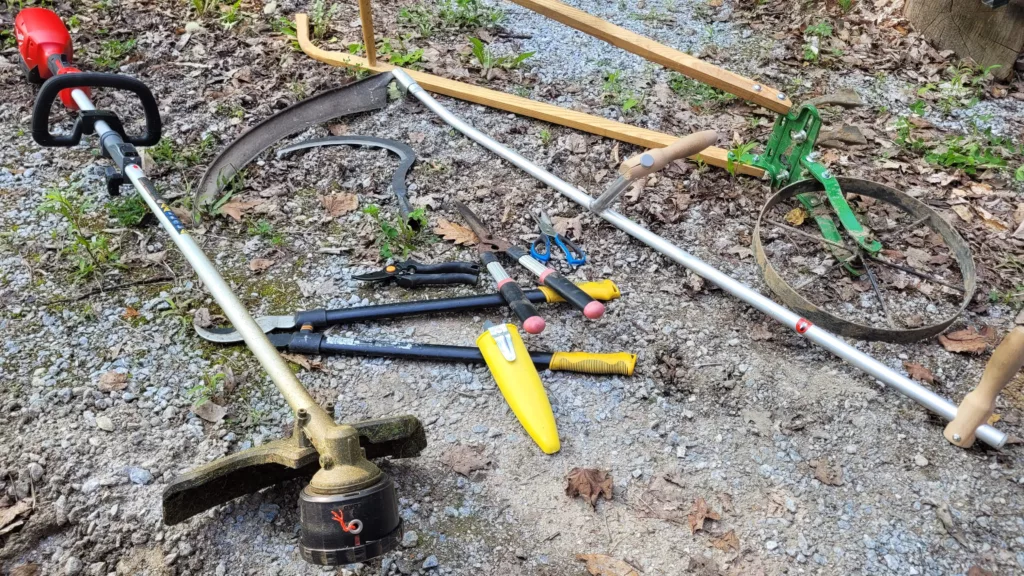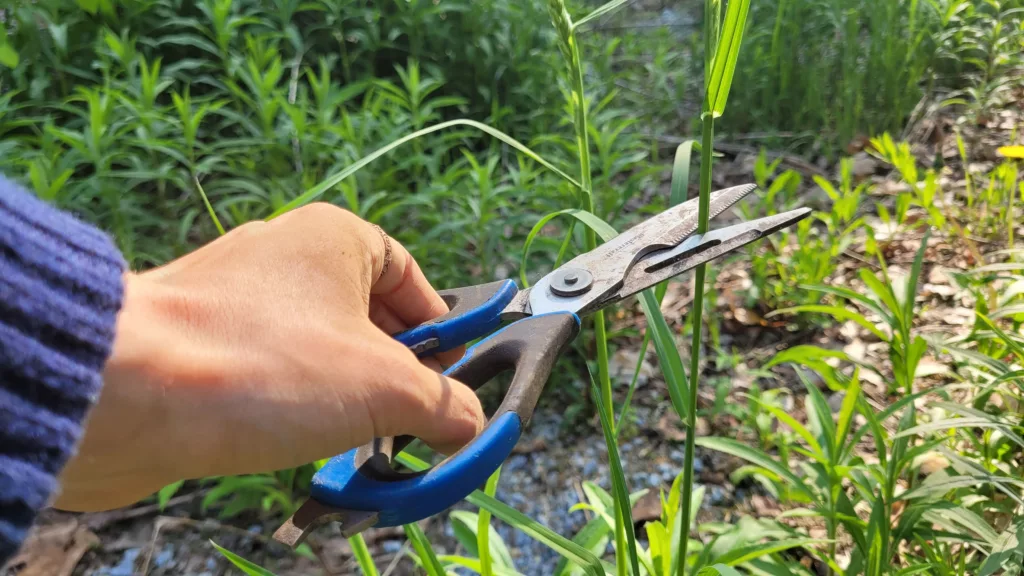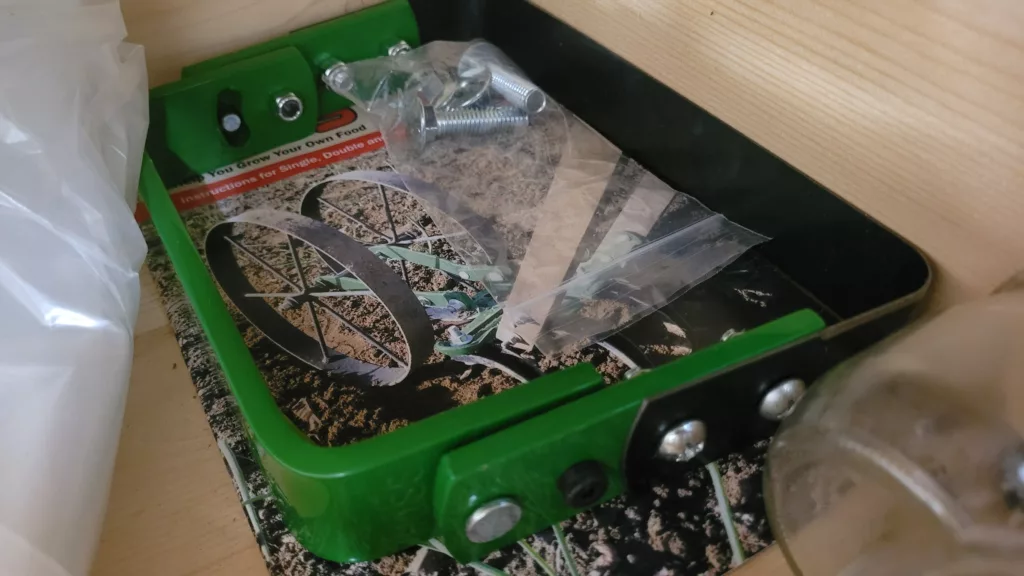This post may contain affiliate links. If you use these links to buy something we may earn a commission. Thanks.
With the best chop-and-drop tools, you’ll carry less out into the field after learning about all the options you may (or may not) need.
Everyday chop-and-drop tools are small, multi-purpose, and long-lasting. The best intermittent chop-and-drop tools are appropriate for the job you need, long-lasting, and safely sharp!
Chopping and dropping is a method of composting material right where it was cut and eliminating the need to transport material to and fro.
You can chop and drop any size of plant material, from soft greens to woody stems, limbs, and even tree trunks. You’ll find all the best tools for every chop-and-drop job you’ll need.

We have used every single tool on this list, own most of them, have gone through and switched over several brands for most tools, and learned a lot. Some get a lot more use than others, so I hope this guides you to choose the best tools you’ll actually use.
The best chop-and-drop tools are:
- Scissors
- Loppers
- Shears
- Hand pruners
- Pruning saw
- Scythe
- Sickle
- Rice knife
- Hori Hori knife
- Machete
- Scuffle hoe
- Oscillating wheel hoe
- Lawnmower
- Weed wacker
In this post, you’ll find more information about them all, when and how to use them, and who makes them best (in our experience).
Each tool is used for specific situations and you’ll learn when to use what for the best (easiest) chop-and-drop experience.
| Tools | Best Use | Average Cost |
| Scissors | Harvesting or ‘weeding’ soft greens | $10 and a lifetime warranty |
| Loppers | Selective pruning of medium woody stems or branches | $22 and a lifetime warranty |
| Lopper shears | Trimming small woody branches or soft greens | $31 and a lifetime warranty |
| Hand pruners | Selective pruning of small woody stems or branches | $14-$35 |
| Pruning saw | Selective pruning of large woody trunks or branches | $24 and a lifetime warranty, + gloves recommended |
| Scythe | ‘Mowing’ small woody stems and soft greens in a large area | $190 from a local farm supply store |
| Sickle | Trimming bunches of small woody branches or soft greens with precision | $20-$80 from Amazon or a small business Etsy shop. |
| Rice knife | Trimming bunches of small woody branches or soft greens with increased precision for smaller spaces | $30-$80 |
| Hori hori knife | Everyday multipurpose weeding, sowing, and harvesting for greens and small woody stems | $24 and lifetime warranty |
| Machete | Overgrown shrubs and bushes around larger plants with space | $30-$60 from Fiskars – not always available on Amazon, but usually in local stores. |
| Scuffle hoe | Cut the base of young or green ‘weeds’ at soil level around plants | $40-$140 on Amazon, linked to the highest rated for quality |
| Oscillating wheel hoe | Cut young or green ‘weeds’ at soil level around plants | $250-$280 for Hoss wheel hoe, $30-$50 for Oscillating attachment |
| Lawnmower/pushmower | Trim short to medium-height greens or small woody stems in a large area | $600-$700 for a powered lawn mower, $150-$200 for a pushmower |
| Weed wacker | Trim medium to tall soft greens or small woody stems in a large area | $400-$600 |
Scissors

Scissors are for soft greens and to keep the blades sharp you want to avoid cutting into the soil.
I use scissors for chopping and dropping while I am harvesting greens, such as nettle. When harvesting, I grab the young tops for harvest, snip them with the scissors, and place them in the basket for efficient work.
When I see unwanted plants growing among my crops, I’ll chop them low with scissors. Grab the unwanted plant, lift it a bit, and chop it low.
Two kinds of scissors work for this: basic fabric scissors or multipurpose garden scissors.
Multipurpose garden scissors last longer, so if you think you’ll use them often, go for the better ones. Otherwise, maybe hand pruners are better for your needs.
Loppers

Loppers are great for selective pruning of small and medium woody branches. This is an intermittent tool unless you have boatloads of trees or small trees to trim all of the time!
Willow trees are often used as a nutrient-rich chop-and-drop crop. Loppers would be used to take off medium-sized wood branches of at least 3-6 years of age, and shears would chop up all the younger 1-3 year growth into smaller pieces or “chips.”
Loppers are not the right tool for cutting up many small branches, it takes too long! They are best suited for a small number of medium wood pruning.
When choosing a set of loppers, avoid the extendable ones, they have too many breakable parts. Over time, these breakable parts will cause problems as loppers rely on a solid foundation to provide the right leverage for making easy cuts. The pair by Fiskars also comes with a lifetime warranty.
Hedge shears

Hedge shears are like giant scissors with greater power. Quickly cut through several small woody branches, even smaller medium-sized woods when sharp.
When looking for the best hedge shears, you’ll also (ideally) want a solid pair without extendable parts for the same reason as loppers. Fiskars does offer an extendable pair with a lifetime warranty though, so that’s worth considering.
Shears make more cuts than loppers do, so a solid build on these is even more critical for longevity, in general.
Good shears also have snug blades. You shouldn’t be able to see “through” the blades as they should be tightly touching, top to bottom, when together.
For more control over cutting bundles of plants or stems, a rice knife may be most suitable.
Hand pruners

Hand pruners are like loppers but (very) short and less powerful. An everyday tool with appropriate blades for general garden plants; flowers, vegetables, and herbs, even most herbaceous perennials.
For large pruning jobs and wood-heavy cutting, electric hand pruners do the squeeze work for you so your hand doesn’t get cramped. For the price, they are best reserved if you need to do a lot of pruning!
The best hand pruners are made with “fully hardened” steel or carbon steel. A low-friction coating also prevents the blades from seizing up from debris or plant sap.
For cutting more than one plant or stem at a time, a rice knife may be more your type.
Pruning saw
Pruning saws are ideal for coppicing large branches or trunks on shrubs or trees.
The best pruning saw is made with hardened steel and has few moving parts (better to avoid foldable saws for longevity).
I linked to the most highly reviewed saw, as we have an older saw that does the job, and we don’t need to do a lot of large pruning yet. While I haven’t used this particular saw, the reviewers love it! We will be getting one as our fruit trees mature.
Most quality pruning saws are hundreds of dollars, so if you’re looking to save, Fiskars saw may be one of the best and longest-lasting options.
Scythe

A scythe is the ultimate permaculture chop-and-drop tool for mowing down wide living pathways or intentional ground covers. It swings through soft greens and small woody stems.
To consider this tool, you’ll need space for swinging it back and forth and a rock-free area.
The learning curve to a scythe is a long one. Not only do you need to learn how to use it, you also need to learn how to keep it sharp.
We aren’t perfect at it yet, but it still works well. It’s been great for saving energy on a lawnmower and is less strenuous to use than a push mower.
Lee Valley provides the scythe with a holster to carry around the water stone. The water stone is meant to sharpen the blade, but we found and later learned that it’s too abrasive. Now, we use a fine sharpening stone for our traditional Austrian-style blade.
It’s recommended to sharpen the blade after every 15 minutes of use. Sharpening the blade takes less than a minute.
Sickle

We bought these beautiful sickles hoping to grab the plants and cut them with ease, however, quickly discovered a serrated blade, or rice knife, is more suitable for what we wanted.
These sickles need you to use a literal chopping motion to actually cut through anything. They aren’t very effective for greens. If you want a “chop” motion tool, this is the one, but it may not be practical for your hope and dreams.
The chop motion of a tool in this shape is also more dangerous than an easy-cutting slicing hand tool. For safe chopping with sickles like these, direct the pointy end away from you.
Rice knife
Rice knives are for everyday chopping and dropping for “handfuls” of plants or grasses. Hand pruners and shears offer less control than a rice knife.
The rice knife has a serrated blade and easily slices through soft greens and small woody stems. The performance of the rice knife is what I had pictured when ordering a sickle.
So if you’re fantasizing about a sickle, consider a nice rice knife, this one is popular because it safely tucks in your pocket or tool belt.
Hori Hori knife
“Hori” means to dig, in Japanese, and “hori-hori” is an onomatopoeia for the sound of digging.
Hori Hori knives a likely your most versatile everyday tool in this list. The knife has a sharp flat blade for every cutting, a serrated blade good for sawing greens and small or medium roots or limbs, and a slight curve to the blade similar to a trowel good for transplanting and weeding.
It comes with a sheath, a long-lasting design, a comfortable handle, a pommel base for the odd hammering, and a twine cutter or bottle opener.
It also has a small ruler on it, making it handy for spacing or depth measuring.
Cheaper hori hori knives can still do plenty of these things, but the one by Barebones has been, by far, the best.
Machete
Machetes are for large over-grown areas with plant material of varying sizes.
A popular tool for agroforestry. Agroforestry mimics and speeds up the natural successions of a forming forest. Speeding up the process involves a lot of chopping and dropping!
Typically agroforest-ers grow from seed or seedlings in straight rows for ease of maintenance and expansion. All the succession plants and natives that grow beside the straight row are allowed to grow for some time and eventually get chopped down and left in place.
This process is repeated, and over time, the established plants have the soil life and structure required to thrive for a long time. A machete is used to maintain these systems even after establishment with vigorous chopping and dropping in between rows.
Scuffle hoe
Scuffle hoes chop weeds at the base of small plants at soil level, or slightly below soil level.
It’s easy to maintain bare soils around perennials, or down rows between vegetables with this tool.
Oscillating wheel hoe

An oscillating wheel hoe is basically a scuffle hoe but on a wheel. Ours is from Hoss Tools.
The wheel makes it easy to prevent overgrown weeds row after row after row without wearing down your back.
Rather than bending over slightly with the scuffle hoe, you can stand completely upright with a wheel hoe and use both arms equally.
The tool does the same job by chopping young plants at the base.

You’ll choose the width of the hoe attachment to how you tend to space your rows for the greatest efficiency.
The wheel hoe is suitable for rows, but not for in and around or between non-straight or tight plantings.
Lawnmower or pushmower
For large areas or wide pathways, mowers are one of the easiest ways to maintain “living mulches” while growing your soil.
Simply ditch the ‘bag’ on your mower and let it all fall in place.
Push mowers cost a lot less dollars, but a lot more manpower and human energy. So what do you wish to save?
A scythe is about the same price as a push mower and cuts easier and faster, but takes time to learn and get good at the technique and maintenance of the tool.
A non-powered option is always great to have on hand should you ever lose access to abundant power supplies.
Weed wacker

A battery-powered weed wacker is a million times more pleasant to use than a gas-powered one. Much quieter and not stinky.
You’ll still need safety glasses, but it’s very easy to maintain smaller paths and edges.
Battery-powered Milwaukee tools are all great, we have a few batteries of varying sizes that power a chainsaw, drill, tire pump, and grease gun. Battery power works best for us since things are run on solar here.
Up next: How to Keep Any Garden Path Weed-Free (Without Chemicals)
Recent Posts
There’s no shortage of full-sun ground covers for zone 4 climates! Each plant in this list can withstand the frigid temperatures and also enjoy the hot sun in summer. Full sun means that a plant...
There's no shortage of full sun ground covers, not even in zone 3! Zone 3 climates offer hot but short-lived summers and very cold winters. So each plant in this list can withstand the frigid...
